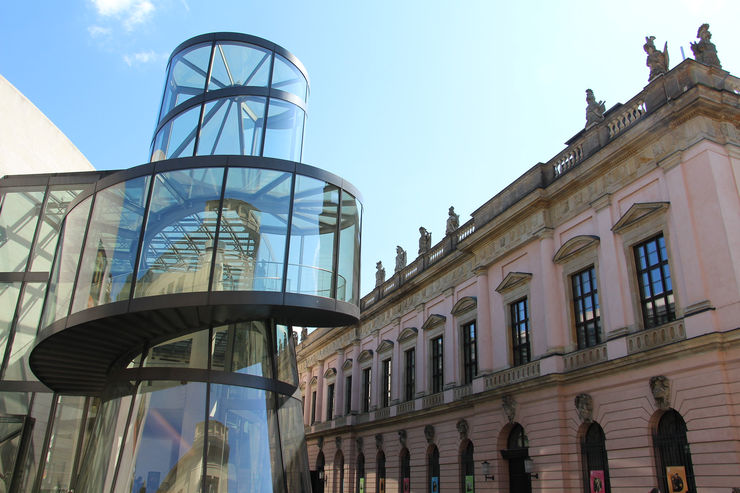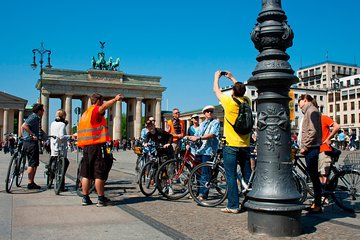German Historical Museum

Renovation Notice
Renovation work on the Zeughaus, home to the German Historical Museum, is expected to last until the end of 2025 and the survey exhibition on German history will be redesigned by then. The Zeughaus café will also close at the end of October and the Zeughaus cinema will move just north to the Pei-Bau at the turn of the year.
All temporary exhibitions will also be on display there: From 9 December, the multi-year exhibition Roads not Taken. Oder: Es hätte auch anders kommen können“ which uses 14 turning points in German history in the 19th and 20th centuries to show that there were often alternatives to historical events.
Housed in the Baroque Zeughaus on Unter den Linden, the Deutsches Historisches Museum (German historical museum) should not be missed. The museum reveals two centuries of German history.
With about 8,000 square meters and 7,000 exhibits you will want to allow plenty of time for your visit. Four hours is not an unreasonable amount of time to spend here and you could easily spend an entire day.
A tour of the Middle Ages to the Current Day
The chronological layout will lead you from the early Middle Ages to the current day.
Follow the conquests of Charlemagne, discover Luther's Theses, study the elements leading to World War II and learn about German reunification.
The items on display cover a broad range from art and everyday items, paintings of historical scenes, armour, a vacuum cleaner to GDR sheet music.
History
In 1987, Chancellor Helmut Kohl signed the founding document for the Museum on the 750th anniversary of the city. A historic moment changed everything. When the Berlin Wall fell, the still youthful Deutsches Historisches Museum Foundation received all pertinent collections and moved to the Zeughaus. The large permanent exhibition you see today opened in 2006.
Exhibits
"German history in images and artifacts" incorporates nine eras over two floors, filled with art and history. Walk chronologically through the upper floor starting with the Middle Ages. Here you will observe a collection of armour. You'll see filigree embroidered tunics that belonged to princes and knights from approx. 1750. From imperial times you can see two-wheeled penny farthing bikes and the first automobiles.
Descending to the first floor, you will discover photographs and old election signs from the Weimar Republic. The exhibits about in the years following World War II deal with the troublesome period of reparation. Here you will see actual CARE packages sent from the United States and maps of German occupied territories.
The tour then leads you to an actual fragment of the Berlin wall,continuing cronologially toward the nineties. All exhibitions in the museum look at historical developments, revolutionary events, and the people behind them. The exhibits offers insight into the great stories and the people behind them, but also, into the lives of ordinary people.
The museum also contains a 165 seat movie theatre where historical and thematic films are shown
Special Exhibitions
After visiting the permanent exhibition, be sure to check-out the special exhibitions housed in the modern Pei building. The Pei building, which opened in 2003, features a helical staircase and a steel and glass foyer.
Highlights
The 3.5 meter high Cape cross weapon column, made of stone (1486) painting by Martin Luther by Lucas Cranach the Elder (1529) 22 masks reliefs for dying giants, under the glass roof of the courtyard (Andreas Schlüter, circa 1690) relic from the battle of Waterloo: Napoleon's stitch hat (1815) Personal computer "PC 1715" of the GDR (1989)
Visiting the Deutsches Historisches Museum
Audio tours are available and recommended for the best experience.
Facts For Your Visit
Fee: YesGerman Historical Museum Hours:
Opening hours may differ on holidays
- Monday: 10:00 AM – 6:00 PM
- Tuesday: 10:00 AM – 6:00 PM
- Wednesday: 10:00 AM – 6:00 PM
- Thursday: 10:00 AM – 6:00 PM
- Friday: 10:00 AM – 6:00 PM
- Saturday: 10:00 AM – 6:00 PM
- Sunday: 10:00 AM – 6:00 PM
Address: Unter den Linden 2, 10117 Berlin, Germany
Phone: 030 203040
Official Website: German Historical Museum
German Historical Museum Reviews
Rated out of 5![]()
![]() They are updating their permanent exhibition so I'm glad the new Pei Bau (architect of the Louvre pyramid) is open for some temporary shows. Not sure what others are expecting?
On the basement they made an effort to tell history in a new way. A lot of What Ifs, like an alternative possibility in history. It reflects a lot of sentiments when things happen - say, what if the assassination (of Hilter) is successful? The layout is cutting edge. The optical illusion layouts seems very innovative, and not too text heavy.
I particularly enjoyed the cold war part and where they draw parallel to the June 4 massacre in Beijing 1989. There was even a well-made iPad graphic novel / interactive game where you can go through what the atmosphere was like in Leipzig in 1989. We will unfortunately never have such storytelling in Hong Kong. So thank you for remembering that part of history.
On the upper levels there's another exhibition about the enlightenment with older / more traditional exhibits, when science just came into lifes of those in 1700s or so.
A rainy afternoon well spent indoors.
They are updating their permanent exhibition so I'm glad the new Pei Bau (architect of the Louvre pyramid) is open for some temporary shows. Not sure what others are expecting?
On the basement they made an effort to tell history in a new way. A lot of What Ifs, like an alternative possibility in history. It reflects a lot of sentiments when things happen - say, what if the assassination (of Hilter) is successful? The layout is cutting edge. The optical illusion layouts seems very innovative, and not too text heavy.
I particularly enjoyed the cold war part and where they draw parallel to the June 4 massacre in Beijing 1989. There was even a well-made iPad graphic novel / interactive game where you can go through what the atmosphere was like in Leipzig in 1989. We will unfortunately never have such storytelling in Hong Kong. So thank you for remembering that part of history.
On the upper levels there's another exhibition about the enlightenment with older / more traditional exhibits, when science just came into lifes of those in 1700s or so.
A rainy afternoon well spent indoors.
Jen Wan - a month ago
![]() Unless you wanna to know and well studied the German history, it's hard to arouses interests by browsing thru so much information provided during the visit. Yet the grimmer past just not my ideal to add on the horrible weather during my stay in Berlin.
Unless you wanna to know and well studied the German history, it's hard to arouses interests by browsing thru so much information provided during the visit. Yet the grimmer past just not my ideal to add on the horrible weather during my stay in Berlin.
Osin Oz - 3 months ago
![]() The building is an attractive example pf modern contemporary german architecture, its very informative and knowledgeable about german history
The building is an attractive example pf modern contemporary german architecture, its very informative and knowledgeable about german history
shihab mac - a month ago
![]() The main building is closed and the Zeughaus is being renovated. The exhibition “Roads not Taken” is located in the Pei Building. This exhibition is about the turning points in German history in the 19th and 20th centuries. The postmodern Pei Building is a great compliment to the historical one.
The main building is closed and the Zeughaus is being renovated. The exhibition “Roads not Taken” is located in the Pei Building. This exhibition is about the turning points in German history in the 19th and 20th centuries. The postmodern Pei Building is a great compliment to the historical one.
AXZ - 5 months ago
![]() The German Historical Museum was a very educational experience. The exhibition I visited was called "Roads Not Taken", basically how things could have turned out differently. Unfortunately they didn't and we know what happened...The building is an attractive example of modern German architecture.
The German Historical Museum was a very educational experience. The exhibition I visited was called "Roads Not Taken", basically how things could have turned out differently. Unfortunately they didn't and we know what happened...The building is an attractive example of modern German architecture.
Jason Whittle - 10 months ago
![]()
Directions
How to get to German Historical Museum by U-Bahn, S-Bahn
Nearest U-Bahn, S-Bahn Line(s): U6, S3, S5, S7, S9
Nearest U-Bahn, S-Bahn Station(s): U Friedrichstraße, S Hackescher Markt
The Deutsches Historisches Museum is best accessed by public transportation. Hackescher Markt and The Friedrichstraße S-Bahn stops are within a 10-minute walk.
From Hackescher Markt on the S-Bahn, follow the neue promonade west to Burgstraße, bear left (south), cross the bridge to Museum Island and continue right across the island and the next bridge to the museum entrance.
From Friedrichstraße on the U-Bahn, walk south on Friedrichstraße, go left on Dorotheenstraße to the river, go right to the bridge, go right again on Bodestraße (at the bridge) to the museum entrance.
Buses 100, 245, 300 State Opera or Lustgarten stop almost right in front of the entrance.
Map & Instant Route Finder
Click&Go Map and Route Finder with public transit, walking, driving or cycling directions. Get up-to-the-minute transit times for your route.
Accommodations near German Historical Museum:
Photo Gallery
-

Photo Credit: Harald Groven - cc license via Flickr -

Photo Credit: xiquinhosilva - cc license via Flickr -

Photo Credit: xiquinhosilva - cc license via Flickr -

Photo Credit: xiquinhosilva - cc license via Flickr -

Photo Credit: xiquinhosilva - cc license via Flickr -

Photo Credit: xiquinhosilva - cc license via Flickr -

Photo Credit: xiquinhosilva - cc license via Flickr -

Photo Credit: xiquinhosilva - cc license via Flickr -

Photo Credit: xiquinhosilva - cc license via Flickr
Video
Please provide consent and/or disable ad blocker to view the video.


